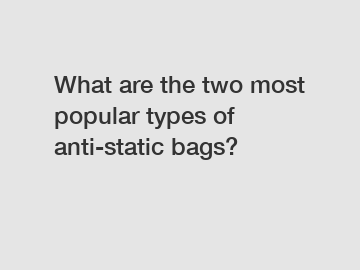Feb. 03, 2024
Environment
What are the two most popular types of anti-static bags?
Anti-static bags are essential for protecting electronic components and devices from damage caused by electrostatic discharge (ESD). These bags are designed to provide a static-free environment, preventing the build-up of static electricity that can harm sensitive electronics. In the market, there are two widely used types of anti-static bags: metalized shielding bags and pink poly bags. Let's take a closer look at these two types and understand their benefits and applications.
1. Metalized Shielding Bags:

Metalized shielding bags, often referred to as static-shielding bags, are made from multiple layers of plastic film. The outer layer consists of an anti-static coating, while the inner layer is made of metallized polyester. These bags provide a robust Faraday cage effect, offering excellent protection against external electrostatic fields.
a. Superior Protection: Metalized shielding bags are highly effective at preventing both the generation of static electricity and the entry of external static charges. They create a barrier that blocks electromagnetic radiation and static electricity, ensuring that sensitive electronic components remain safe during transportation and storage.
b. ESD-safe: These bags are designed to meet strict electrostatic discharge standards, making them ideal for packaging and shipping electronic devices like circuit boards, sensitive integrated circuits, and other static-sensitive components. They effectively dissipate any static charges present on the bag's outer surface.
c. Transparency: Many metalized shielding bags are transparent, allowing for easy visibility and content identification without the need for opening the bag. This feature is particularly useful in manufacturing facilities or when bulk packaging is involved.
2. Pink Poly Bags:
Pink poly bags, also known as pink anti-static bags, are made of low-density polyethylene (LDPE) with an added anti-static agent. These bags offer a cost-effective solution for protecting static-sensitive devices, especially for non-sensitive items that require basic anti-static protection.
a. Basic Protection: Pink poly bags provide a lower level of protection compared to metalized shielding bags, but they still offer significant benefits against static discharge. They are suitable for packaging items that have a lower sensitivity to static electricity or items that will be further protected by other means within a controlled environment.
b. Versatility: These bags are available in various sizes and shapes, making them suitable for a wide range of products, such as cables, connectors, tools, and non-integrated circuit components. Their flexibility and convenience make them popular for general use, such as organizing and storing small electronic parts.
c. Cost-Effective: Pink poly bags are typically more affordable compared to metalized shielding bags. This makes them an economical choice for businesses that need static protection but don't require the high-level protection provided by the metalized bags.
In conclusion, when it comes to protecting electronic equipment and components from electrostatic discharge, metalized shielding bags and pink poly bags are the two most popular types of anti-static bags. Metalized shielding bags offer superior protection and are ideal for highly sensitive electronic devices that require the utmost safeguarding against static electricity. On the other hand, pink poly bags are a cost-effective option suitable for less sensitive items or for added protection within a controlled environment. Businesses should consider their specific needs and the level of protection required to make an informed decision on which type of anti-static bag to use.
The company is the world’s best Epe Foam Bag, Epe Tv Bag, Advanced anti-static bags supplier. We are your one-stop shop for all needs. Our staff are highly-specialized and will help you find the product you need.
If you are interested in sending in a Guest Blogger Submission,welcome to write for us!
All Comments ( 0 )